Abstract: This article provides a brief historical account of the Mazarine Blue (Cyaniris semiargus) in the British Isles and, in doing so, makes observations that have either not been previously documented or have not been appropriately emphasised, with regard to the habitat, distribution, flight times and extinction of this species.
While researching literature related to the Mazarine Blue (Cyaniris semiargus) and, especially, examining the data associated with several historic specimens of this species, several interesting findings have emerged. The first is that, although the butterfly is associated with meadows and fields where the primary larval foodplant, Red Clover (Trifolium pratense), occurs, there is evidence that the butterfly was also found in woodland. The second is that a specimen with a label dated 1905 has been located; the previous latest historic sighting occurring in 1903. The third is that specimens have been found from North Wales which would extend the known distribution. The fourth and last finding is that, based on the data associated with certain specimens, the flight time extended into September (possibly the result of a second brood) which is later than previously considered.
According to Ford (1945), the great naturalist John Ray is possibly the first to provide us with a description of this species, in his Historia Insectorum (Ray, 1710). However, it is possible that Ray was actually referring to the Small Blue (Cupido minimus) or the Silver-studded Blue (Plebejus argus). Salmon (2010) wrote that Ray's description is insufficiently precise to be certain.
The Mazarine Blue (C. semiargus) was a very local and uncommon butterfly in Britain. William Lewin (1747 - 1795), in his Papilios of Great Britain (Lewin, 1795), described this butterfly as the "Dark Blue", giving it the specific name cimon, and wrote "this is a very rare species with us" and gives his account of his discovery of this species: "In August 1793, I took two or three flying in a pasture field at the bottom of a hill near Bath".
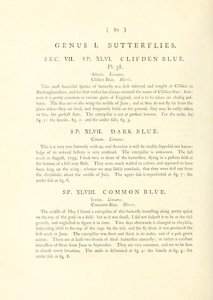 | 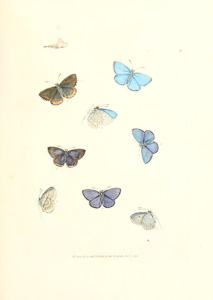 |
| Figure 1a - Text from Lewin (1795) using the vernacular name "Dark Blue" | Figure 1b - Plate 38 from Lewin (1795). Figs. 6 (bottom right) and 7 (bottom centre) show the species |
Lewin's account was followed by Haworth, in 1828, who considered it our rarest butterfly (Dale, 1890). As the number of lepidopterists grew, more localities were recorded for the Mazarine Blue in Britain. From Edward Newman's great work, The Illustrated Natural History of British Butterflies (Newman, 1871), we find it had been found in small numbers in scattered localities in England and South Wales where it occurred mainly in lowland meadows and also, but less frequently, in rough fields on chalk and limestone.
One of the more unusual mentions, however, is that this butterfly of meadows and fields was found at Sywell Wood near Northamptonshire by the Rev. D.T. Knight, who had informed the Rev. F.O. Morris (Morris, 1853). This is the first hint that the butterfly was found in woodland and this is considered further later in this article.
The most detailed account we have of this species in Britain is from the diaries and notebooks of James Charles Dale (1791-1872). His son, Charles William Dale (1852-1906), includes full details of the Mazarine Blue, based on his father's records, in his book The History of Our British Butterflies (Dale, 1890). In it, he tells the story of his father, the wealthy squire of Glanvilles Wootton, who recorded the Mazarine Blue in several of his pasture meadows from 1808 to 1841. Two of J.C. Dale's specimens were figured in Ford (1945) on plate one - Historic Butterflies.
C.W. Dale also mentions that the butterfly disappeared from Gloucestershire in 1849 and from Cambridgeshire in 1850. In Glamorganshire, which held a particularly strong colony, it had gone by 1877. Dale adds, "At Tenby, in Pembrokeshire, one was taken by Mr Edward flying over thyme in 1883. This appears to be the last specimen seen in the British Isles". Thomas and Lewington (2010) mentions that the butterfly was rumoured to have hung on in Lincolnshire until 1903 and habitat change was probably responsible for its extinction.
Specimens of the Mazarine Blue from the 19th century, a few in perfect condition, can be found in certain museums and a few private collections. At the Oxford University Museum of Natural History (OUMNH) there is a good series of historic Mazarine Blue specimens in the Dalean and British collections. The Dale collection contains examples of both sexes from Glanvilles Wootton in Dorset, and also several males from Cardiff.
Specimens of the Mazarine Blue with good data are extremely rare, with many lacking important information such as date and locality of capture. One good example is from the butterfly collection donated to the OUMNH by The Reverend Francis Mosley Spilsbury (1826-1878). Spilsbury's series of Mazarine Blues held in the British collections at Oxford have no data except for his name, in short: 'Spils'.
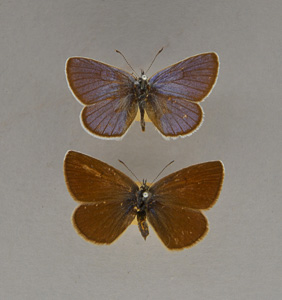 |
| Figure 4 - A male and female Mazarine Blue presented to the OUMNH by the Rev F.M. Spilsbury in 1878 Image © Peter Andrews |
In the same cabinet drawer there are, amongst other specimens of the Mazarine Blue, a small series that have surprisingly good data for the period they were collected. These were taken by the Reverend Professor John Stevens Henslow (1796-1861), a distinguished botanist and geologist, who is best remembered as a friend and mentor to his pupil, Charles Darwin.
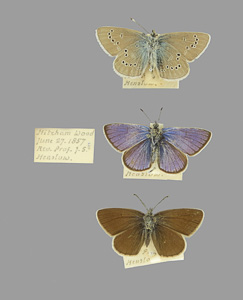 |
| Figure 5 - Specimens captured by J. S. Henslow at Hitcham Wood during 1857 Image © Peter Andrews |
Recently, when I was viewing a large historic private collection, I came across two Mazarine Blue specimens from the collection of G.B. Kershaw, together with many of his unique aberrations of other species. The specimens are shown in Figure 6 and Figure 7 and, as we shall see, these have historic importance.
The first specimen was found in a cobweb and is shown in Figure 6 and certainly looks like it has received the attentions of a spider. The labels on both of the Kershaw specimens have been transcribed and further larger labels placed below them. The data placed below the G.B. Kershaw specimen found in the cobweb shows a date of 2nd September 1905, and the other a date of 13th August 1905.
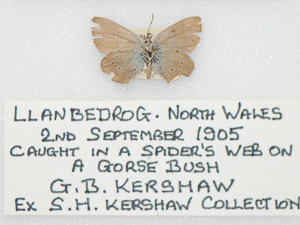 | 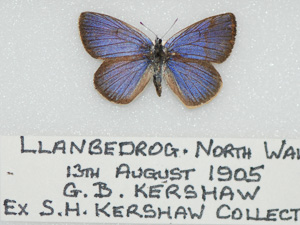 |
| Figure 6 - Specimen captured in a cobweb in North Wales by G.B. Kershaw during 1905 Image © Peter Andrews | Figure 7 - Specimen captured North Wales by G.B. Kershaw during 1905 Image © Peter Andrews |
The data that accompanies Henslow's specimens is even more important than the actual condition of the specimens themselves, since they show that the specimens were taken in a wood near Hitcham, Suffolk on the 27th June 1857, suggesting that the butterfly was found in woodland, as previously documented in Morris (1853).
The analysis of literature provided earlier in this article shows that C.W. Dale thought that the last specimen was seen in 1883 (Dale, 1890), and Thomas and Lewington (2010) states that specimens from Lincolnshire were rumoured to last until 1903. However, the data labels associated with the Kershaw specimens (Figures 6 and 7) clearly show a date of 1905. It would, therefore, now appear that the last Mazarine Blue that was ever seen in Britain was on the 2nd September 1905 at Llanbedrog in North Wales.
G.B. Kershaw's brother, Colonel Sidney H. Kershaw D.S.O. (1881-1964), of Bletchley in Buckinghamshire, wrote a short article in the Entomologist's Record and Journal of Variation (Kershaw, 1955): "I think I can claim the last record of the capture of Cyaniris semiargus Rott in Great Britain for my late brother; in late August or early September 1905. It was in a meadow, some way up a stream in Llanbedrog in North Wales not far from Aberystwyth. His wife drew my brother's attention to a butterfly in a cobweb. He identified it as semiargus and a female, and shortly afterwards took a male flying close by quite fresh. Both specimens are now in my collection. He did not see any others during the rest of his stay".
If the two specimens were, in fact, taken at the same time, as S.H. Kershaw suggests, then the data on the male shown in Figure 7 may be erroneous, it may have been transcribed wrongly or is it possible that Kershaw was mistaken? I believe that G.B. Kershaw's account (that the Mazarine Blues were collected on the same day) is correct; he is unlikely to have forgotten such an interesting story told to him by his brother of the remarkable find of two Mazarine Blues, a great rarity, on the same day.
I do not know why these almost certainly-genuine captures by G.B. Kershaw have been ignored in modern literature. It seems much of S.H. Kershaw's large collection was not presented to a museum, but went to auction, before ending up in a private collection where it has, perhaps, remained unnoticed. Perhaps the unusual dates of the captures are considered questionable.
The Kershaw specimens (Figures 6 and 7) also show that the butterfly was found in North Wales, extending the previously-documented distribution.
The date of the G.B. Kershaw specimens is also later in the year than previously known. Lewin (1795) captured this species at the end of August, although he mentions they were in "a wasted condition". Although this species is generally single brooded in Northern Europe (and most British records are from June and July), I believe that in exceptional circumstances (such as in very hot years) there can be a small second brood which accounts for the latest capture of the Mazarine Blue, on 2nd September 1905.
Since first writing this article, I have been asked to comment on the following statement in Emmet and Heath (1990): "The origins of ... two caught in North Wales in August and September 1907 must remain doubtful". Assuming that this statement is with reference to the G.B. Kershaw specimens, I would argue that not only did the authors fail to give the correct date (of 1905), but there is also no explanation for why these specimens are considered doubtful, especially when they were taken by a reputable collector. It is, therefore, the opinion of this author that the specimens are genuine and should be recognised as such.
I would like to thank James Hogan and Gina Allnatt for their time and help at the Oxford University Museum of Natural History, and Peter Eeles for his editorial guidance.